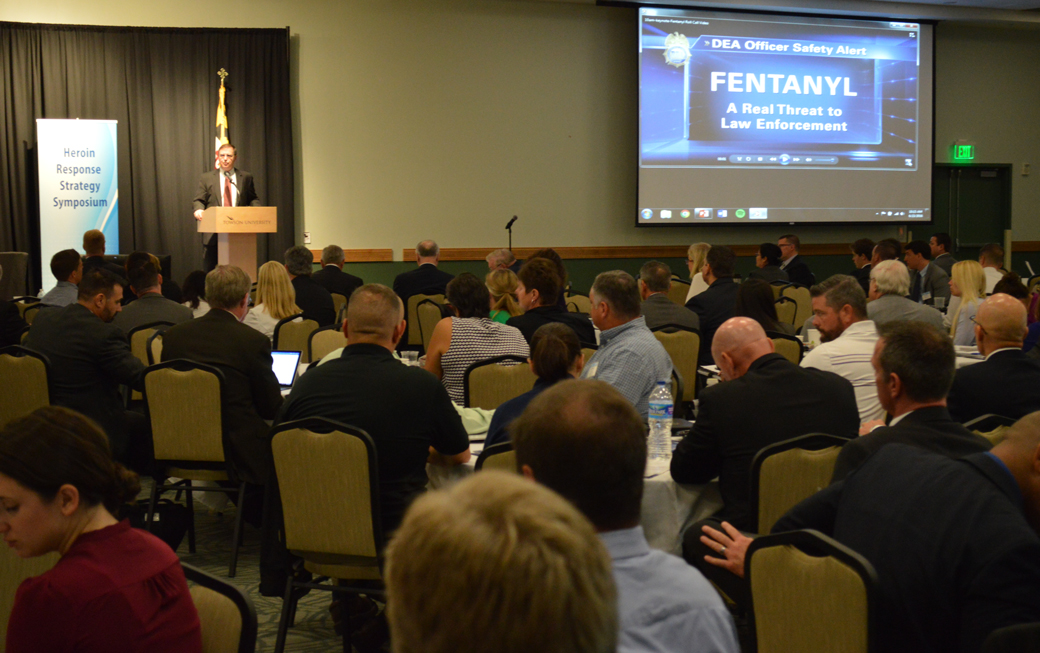HIDTA hosts "Heroin Response Strategy Symposium" on TU's campus
The two-day symposium brought together nearly 350 experts and professionals in the fields of drug treatment, research, law enforcement and prevention to help share solutions on the growing heroin/opioid epidemic.

There’s an old saying that goes something like “Where there is a problem, there is also a solution.” That’s why this week, experts converged on Towson University to discuss finding solutions to America’s heroin/opioid problem.
The Washington/Baltimore High Intensity Drug Trafficking Area (HIDTA) partnered with Towson University’s Division of Innovation and Applied Research to host the Heroin Response Strategy Symposium on June 22 and 23 at TU’s West Village Commons.
The two-day symposium brought together nearly 350 experts and professionals in the fields of drug treatment, research, law enforcement and prevention to help share ideas, solutions and strategies on how they are fighting the growing heroin/opioid epidemic in their respective areas.
“We are very pleased to host and be a partner in today’s symposium on this most important issue that’s impacting our friends, families, loved ones and communities across the United States,” said Towson University President Kim Schatzel during her welcoming remarks Wednesday morning.
“This is a regional and national epidemic,” she added. “Our response, as shown today, needs to be comprehensive as well as collaborative.”
According to the Center for Disease Control and Prevention, the number of overdose deaths involving opioids has nearly quadrupled since 1999. The United States Drug Enforcement Agency recently announced that drug overdose is the leading cause of death, ahead of both car accidents and firearms.
In 2013, the most recent year for which data is available, 46,471 people in the United States died from drug overdoses, and prescription painkillers and heroin caused more than half of those deaths.
With record-high numbers in overdose deaths, the goal of the symposium was to facilitate collaboration between public health and public safety partners within and across jurisdictions, sharing best practices, innovative pilots, and identifying new opportunities to leverage resources.
Speakers at the symposium included Michael Botticelli, director of the Office of National Drug Control Policy; Kevin Davis, commissioner of the Baltimore Police Department; Boyd Rutherford, lieutenant governor of the state of Maryland; Chuck Rosenberg, acting administrator of the Drug Enforcement Agency; and Michael Gottlieb, national director of HIDTA.
“It’s really historic with the group of people we have here today,” Botticelli said during his presentation. “Ending this epidemic is going to take everyone working together, and it’s so good to see everyone here today working together.”
Thursday’s morning session opened with remarks by Baltimore Orioles’ great and National Baseball Hall of Fame inductee Cal Ripken, Jr., founder of the Cal Ripken, Sr. Foundation and the Badges for Baseball program. That program emphasizes the importance of building the relationship between members of law enforcement and young people in at-risk communities.
Ripken told the packed West Village Commons ballrooms about the role his father played in his development of the Ripken Foundation and the Badges for Baseball program.
“To be honest, it wasn’t until I lost my dad to lung cancer at age 63 that I truly focused on the importance of helping kids,” said Ripken, now 55. “One of my favorite interactions with kids was in a gym in DC. As someone who grew up around baseball, I was surprised that most of the kids in that gym didn’t know anything about the game. Some held the bat at the wrong end, and most of them couldn’t come close to hitting the ball when it was pitched to them.”
Ripken recalled that one young boy, who was small in stature compared to the others in the club, stepped up and asked if he could try.
“On his first swing he hit the ball across the gym,” Ripken said with a smile. “To see the pride on that young man’s face when he hit that ball was so rewarding. I have to admit, ‘Badges for Baseball’ is my favorite Cal Ripken, Sr. Foundation program. I’m happy we’re able to have a small role in this important effort to build relationships between kids and law enforcement. It’s a tribute to my dad’s legacy, and that’s what it’s all about.”
The HIDTA Program is a federal grant program administered by the White House Office of National Drug Control Policy that provides resources to assist federal, state, local and tribal agencies coordinate activities that address drug trafficking in specially designated areas of the United States.
In addition to working with HIDTA to host this event, Towson University works to fight this drug epidemic with research and technical assistance, program evaluation, education and community engagement.
Towson University is the largest university in the Baltimore area and recently launched Schatzel's Baltimore-Towson University (BTU) priority. BTU elevates the work the university is already doing with its many partners throughout Greater Baltimore to better address the needs of the region.
By hosting the HIDTA and the Heroin Response Strategy Symposium this week, Towson University continues to find different and innovative ways to help make the Greater Baltimore region a better place to live, work and raise a family.
“This symposium is another piece of evidence of the impact Towson University has on the region,” Schatzel said. “We firmly believe that institutions in higher education, like Towson University, play a key role in this effort.”